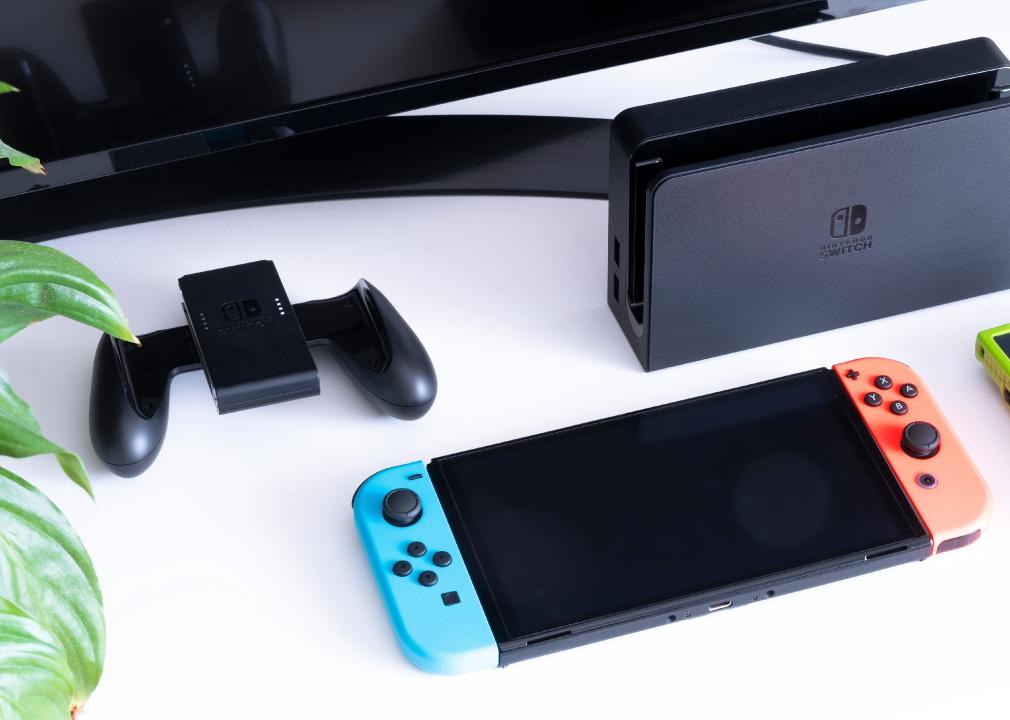The bestselling video game consoles of all time—and dramas behind them
Juan Ci // Shutterstock
The bestselling video game consoles of all time—and dramas behind them
Nintendo Switch video game console next to the TV in a home living room.
Competition between brands is prevalent in every major industry, but few battles are as fierce as the ones fought in the video gaming landscape. Going back to the late 1980s and early ’90s, major companies engaged in fierce sales and marketing fights over their home video game consoles. Sega and Nintendo were the top console manufacturers during these early “console wars” days, with Sega declaring that its Genesis console could do what “Nintendon’t” in a memorable commercial campaign.
School children drew battle lines at recess, debating over which console was the best, and gamers young and old would become increasingly fixated with sales numbers, like fans cheering for their favorite sports teams.
Into the 1990s and 2000s, major tech companies Sony and Microsoft entered the video game industry, eventually pushing Sega out of the competition. Today, the major video game console brands are Nintendo, Sony’s PlayStation, and Microsoft’s Xbox.
Through reported figures by the “big three” console manufacturers and retailers, market research firms and sales tracking websites have produced approximate sales numbers for every major video game console. These figures provide video game enthusiasts with a snapshot of a fast-moving industry. You might see one console succeed over its contemporaries due to its stronger software library, or perhaps because it had an innovative feature that attracted nongamers into purchasing it. Nintendo, Sony, and Microsoft have each had triumphant successes and very public failures—and their sales numbers show it.
Casino Bonus CA analyzed the historical sales numbers of consoles, present and past, using sales trackers on VGChartz as of Sept. 30, 2023. These figures include both home video game consoles plugged into the television (e.g., Xbox 360) and handheld consoles for portable play (e.g., Game Boy). The graphics and charts in this story distinguish the market share between North America, Europe, and Japan, which are the biggest markets in the world for the three major companies.
Read on to see where your favorite video game consoles rank.
![]()
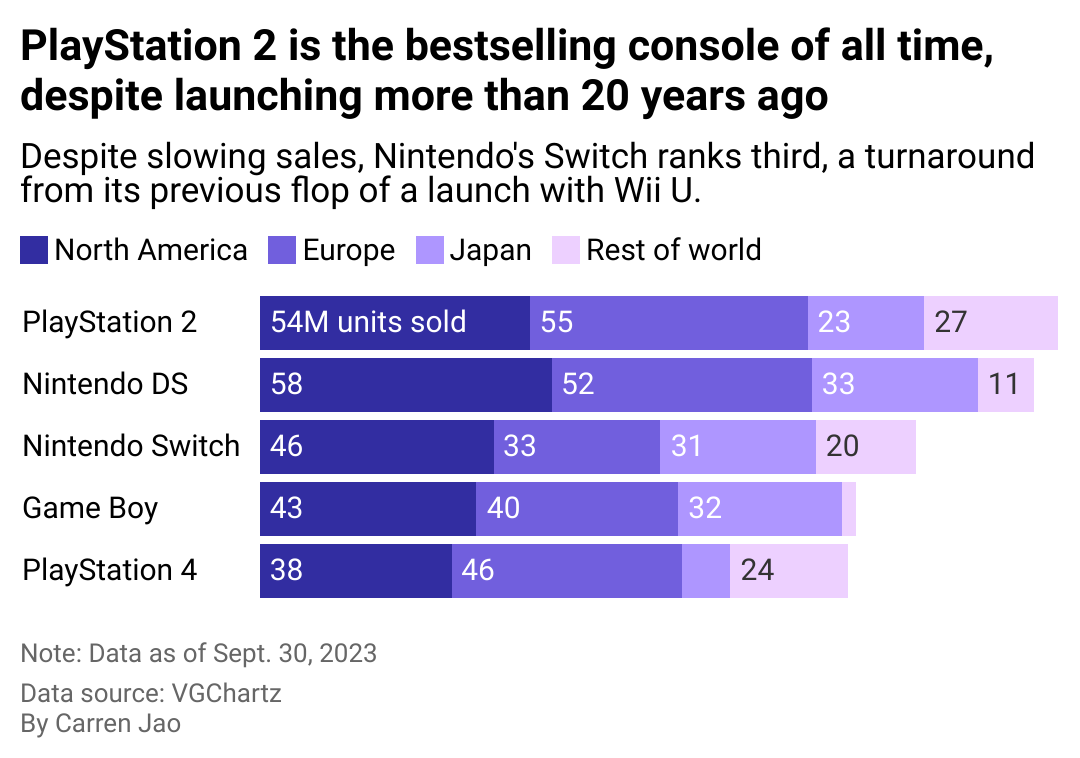
Casino Bonus CA
Sony’s PlayStation 2 leads the list, but Nintendo represents the bulk of the top 5 bestsellers
This stacked bar chart shows the top 5 consoles or handhelds sold in the millions of units sold. PlayStation 2 leads the list with 158.7 million units sold, followed by Nintendo DS (154.03 million) and Nintendo Switch (130.41 million) as of September 30, 2023.
Hitting the market in 2000, the PlayStation 2 was and still remains the bestselling video game console of all time. With almost 160 million units sold in its lifetime, the PS2 far surpassed its contemporaries, the Nintendo GameCube (which now occupies the #22 spot on the list of bestselling consoles) and Microsoft’s Xbox (#20 on the list). The PS2 remains a model example of how a video game console can succeed against the competition, with numerous strengths that led to its staying power.
One of the key factors in PS2’s success was time. The PS2 launched more than a year ahead of Xbox and GameCube in all territories. The latter two launched toward the end of 2001. By the time PS2 was released, the first PlayStation console had already established a strong brand for Sony’s video gaming venture, even defeating the Nintendo 64 in sales. Sony was the market leader at the time, and the second PlayStation console only continued the brand’s momentum.
Despite having twice the memory and processing power of PS2, the Xbox still failed to convince consumers. Third-party game publishers supported the PS2 en masse, knowing that their games would reach wider audiences. Companies such as Square Enix, Konami, and Rockstar would launch games exclusively on the platform, including Final Fantasy X, Metal Gear Solid 2, and Grand Theft Auto: San Andreas, which all went on to become bestsellers.
DVD technology would be another factor in favor of the PS2. By 2000, the DVD was the standard format for movie home releases, and having a relatively cheap DVD player in the PS2 was a selling point for consumers who didn’t even play games.
The PS2’s success led to a long life. The model stayed in production for 12 years. It was only in 2013—long after the PlayStation 3 was released in 2006—that Sony ceased manufacturing the model.
Meanwhile, right behind the PS2 with at least 154 million units sold is the Nintendo DS, a foldable dual-screen handheld released in 2004. A successor to the massively successful Game Boy and Game Boy Advance line, the only major competition was Sony’s PlayStation Portable, which came out in 2005 in most territories. While the PSP was a more powerful device with a larger screen, the dual-screen nature of the DS was attractive to game developers, who created unique games that consumers took an interest in.
Games like Brain Age took advantage of the DS stylus and touch screen, inviting casual players and promoting quick game sessions. Nintendogs allowed players to interact with puppies with controls, and Animal Crossing: Wild World gave players something to do every day. Essentially, the DS became a part of owners’ routines. Meanwhile, the PSP struggled with its higher price and lack of appealing games.
The most recent console to hit the top five bestsellers is the Nintendo Switch, which debuted in 2017. As a “hybrid” platform, the Switch is playable both on the television and as a handheld device. With a massive library of games and a remarkable concept that is easy to sell, the Switch has already become the third bestselling console of all time, with about 130 million units sold, and counting.
The writing is on the wall for the Nintendo Switch, however. Reports point to a next-generation successor that could release as early as 2024. Could the Switch overtake DS in sales as its time on the market dwindles? The Switch is significantly more expensive than the DS was in its lifetime, so the record set by the DS could remain a pie in the sky for Nintendo.
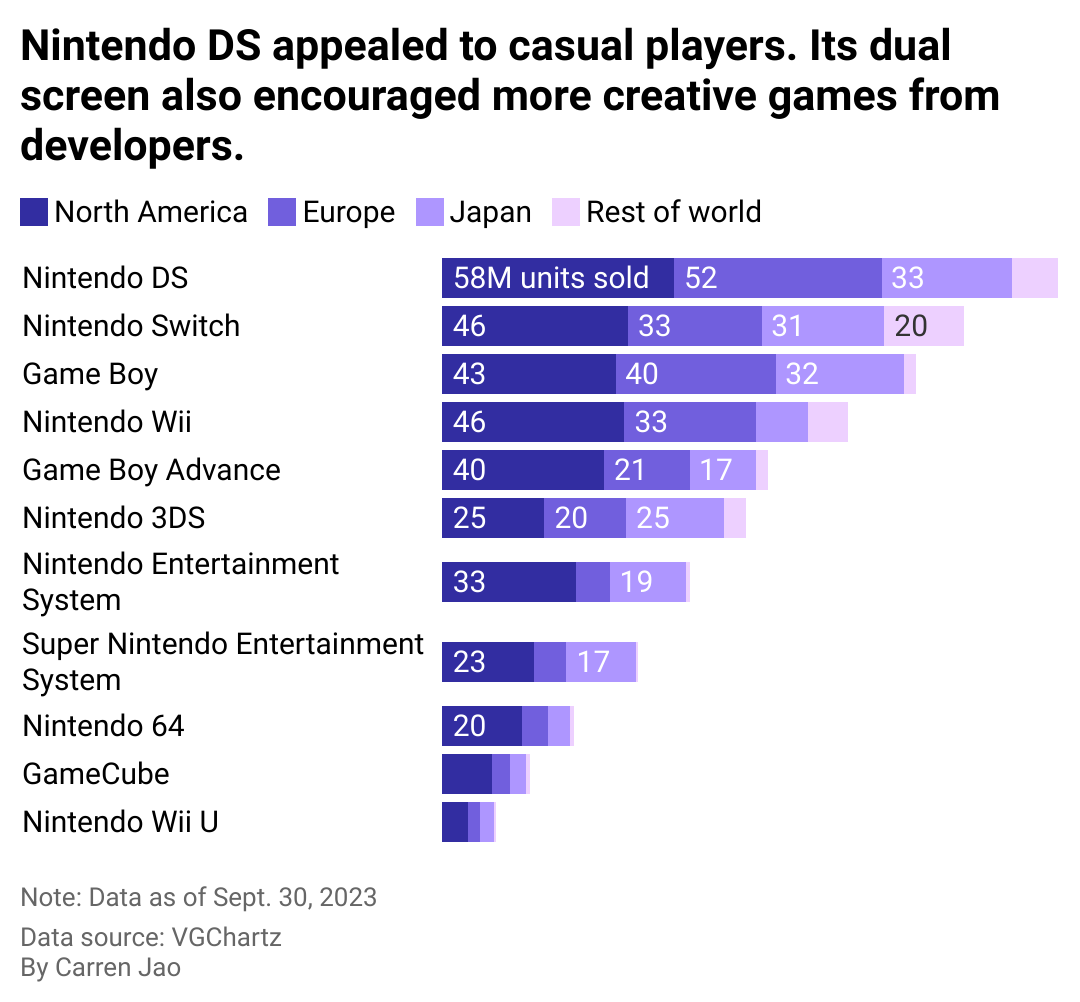
Casino Bonus CA
Nintendo’s blue ocean strategy
The stacked bar chart shows lifetime sales for Nintendo consoles and handhelds. It is led by Nintendo DS with 154.03 million sales, followed by Nintendo Switch at 130.41 million units sold.
Because of Nintendo’s origins as a playing card company, it’s no wonder that the concepts of play and fun have always been central to the weird and wonderful consoles from the Japanese company. Out of the “big three” console manufacturers, Nintendo undoubtedly has the most recognizable characters and properties, including The Legend of Zelda, Animal Crossing, Pokémon (which Nintendo only partially owns), and Super Mario—a property as recognizable as Disney’s Mickey Mouse.
As technology evolves, Nintendo sometimes takes some different directions. While Sony’s PlayStation went with CDs as the format for its games, Nintendo stuck with cartridges with the Nintendo 64, as it did with the Nintendo Entertainment System and the Super Nintendo Entertainment System. Developers flocked to the PlayStation due to the CD’s technical capabilities and lower production cost.
Sometimes, instead of relying on old formats, Nintendo would try something entirely new. While Microsoft and Sony drew blood and fought over graphical power with the Xbox 360 and PlayStation 3, Nintendo took a “blue ocean” strategy by carving out its own space in the market to create something unique with the motion-controlled Wii in 2006. What resulted was a pop culture phenomenon that brought nongamers into the fold—software like Wii Sports and Wii Fit appealed to consumers who never even picked up a conventional video game controller, and the sales figures reflect that.
But with every success like the Wii, there’s also a bomb like the Wii U, Nintendo’s first HD console released in 2012, in the wake of the massive boom of the Wii and a full year before Microsoft’s Xbox One and Sony’s PlayStation 4.
The Wii U confused gamers with its controller setup and, noticing the weak reception for non-Nintendo games on Nintendo systems, third-party studios opted not to develop new and exciting games for the new console. The Wii U became Nintendo’s lowest-selling home console.
It would take until 2017 with the Nintendo Switch, a platform with a much stronger concept, to bring the company back to its former sales glory. While the Switch lacks graphical power due to its handheld nature, it proves that Nintendo’s blue ocean strategy still very much works.
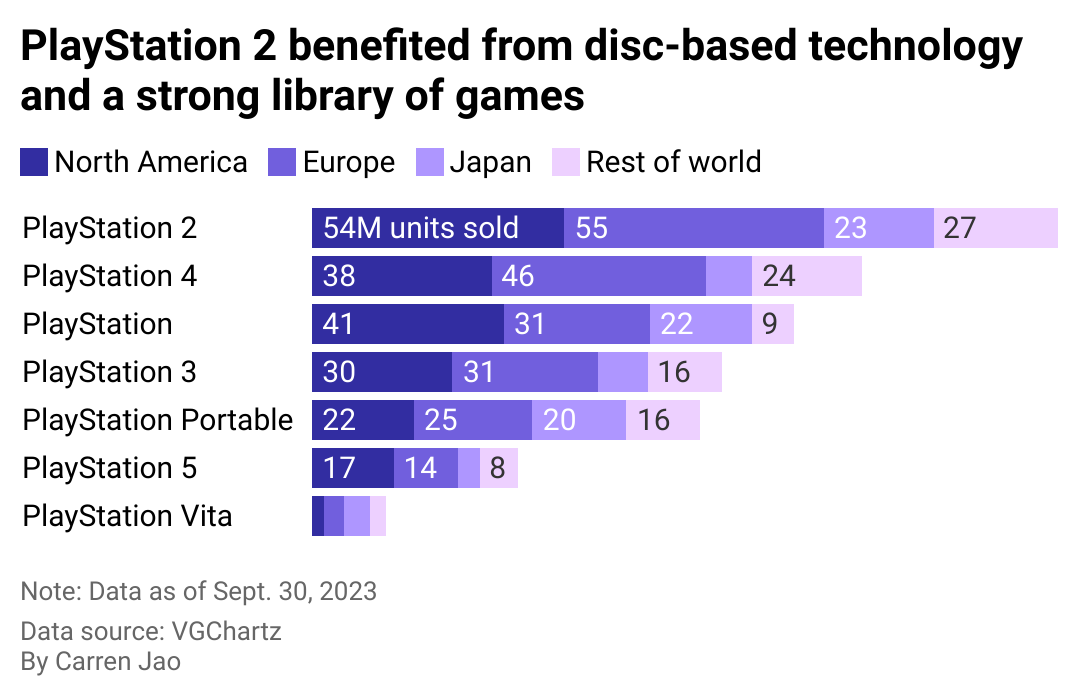
Casino Bonus CA
Sony’s reluctant entry into the video game industry
This stacked bar chart shows the sales of all Sony consoles and handhelds in millions of units sold. Of all the Sony consoles, PlayStation 2 is the bestselling (158.7 million units sold) followed by PlayStation 4 (117.14 units sold).
Japanese corporation Sony has its hands in a number of industries, including consumer electronics and film production. But video gaming was a nascent industry the well-established conglomerate wouldn’t have anything to do with were it not for Sony Computer Entertainment engineer Ken Kutaragi, the company’s former CEO and chairman.
Kutaragi worked on a prototype for a disc-based add-on for the SNES that would have been in collaboration with Nintendo called the “Play Station.” But Nintendo went back on a deal—but not before the infamous prototype was revealed. Sony eventually went its own way with the PlayStation name, and the rest is history.
Both the PlayStation and its direct successor surpassed the Nintendo 64 and the GameCube, respectively, in sales—Sony had become the market leader over the company that could have collaborated with it. The first two PlayStations enjoyed the benefits of disc-based technology, strong software support from game publishers, and a powerful brand name, indirectly leading to Nintendo’s then-competitor Sega’s exit from the console-making business in 2001.
Unfortunately for Sony, the PlayStation 3 had some growing pains. Debuting in the market with the infamously high price of $599 USD in 2006, the PS3 started off as a mockery due to its lack of software support at launch, despite its high power and support for Blu-ray Discs. A large part of this was the difficulty that developers had with the PS3 hardware due to its unique Cell processor. It took some reliable PlayStation franchises such as Gran Turismo, God of War, and Uncharted, along with some memorable marketing to win back the goodwill of consumers later into the PS3’s lifespan.
The PlayStation 4 released in 2013 and saw Sony come back as the market leader in console sales, at least when put up against Microsoft’s competing Xbox One and Nintendo’s straggling Wii U. Interestingly enough, even with the success of the PS4, which is Sony’s second bestselling platform ever, sales in Japan faltered for the PS4 compared to the PS2. It’s difficult to pinpoint the exact reasons for this, but industry observers have seen Sony focus more on the Western and U.S. markets than Japan. The bestselling games for the PS4 include Marvel’s Spider-Man, a God of War revival, Uncharted 4, and a remastered The Last Of Us, all developed by U.S.-based studios owned by Sony.
The trend continues with the PlayStation 5, which also had the misfortune of launching in 2020 during the first year of the COVID-19 pandemic. While the PS5 has only been on the market for a few years, a number of factors have contributed to its lower sales. The console has not been able to meet the high consumer demand partly due to supply chain shortages. A high price point (not to mention inflation) also makes it a harder sell to consumers.
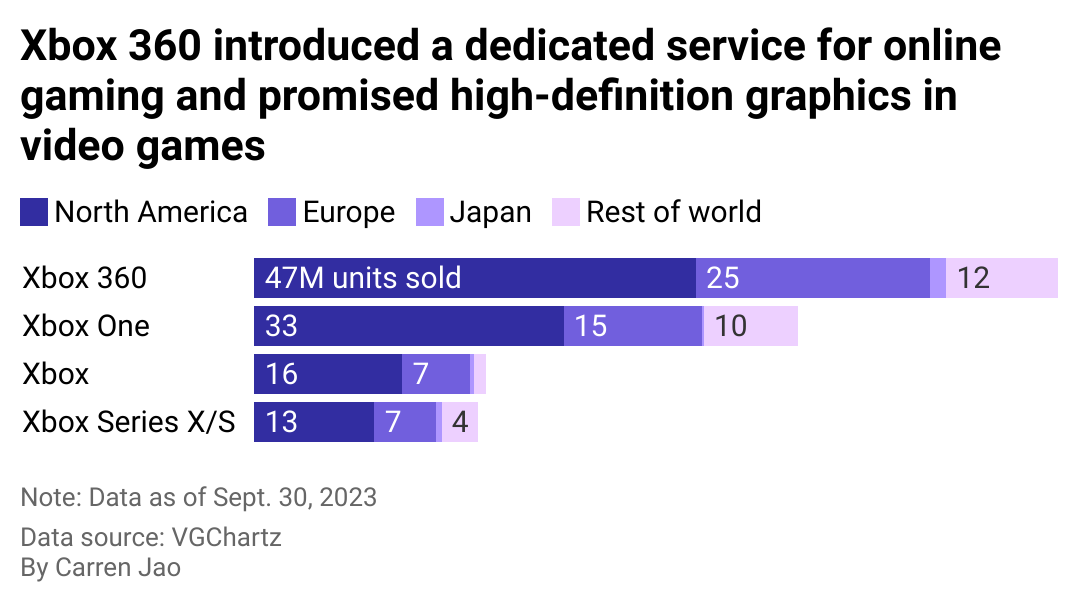
Casino Bonus CA
Microsoft’s bets outside the Xbox
This stacked bar chart shows the sales of Microsoft consoles. The leading Microsoft console is the Xbox 360, which sold 85.73 million units as of September 30, 2023.
Anyone who has used a computer undoubtedly has some familiarity with Windows, Microsoft Office, and other pieces of software from the company. But growing an entire division based on video game hardware was a bold and ambitious move, and Microsoft’s journey in the industry is full of ups and downs.
While Microsoft created a solid brand with the first Xbox console in 2001, it was the Xbox 360 in 2005 that gave the company its biggest success. The 360 standardized a number of elements now present in video game hardware, including a dedicated service for online gaming, support for both physical and streaming media, and high-definition presentation and graphics. The Xbox 360 also had a full-year head start on the Wii and the PlayStation 3, the latter stumbling at launch partly due to its high price point.
The Xbox 360 had a strong library of games, strengthened by Microsoft’s own Halo franchise. Despite sharing some games with the PS3, gamers played popular titles such as Call of Duty primarily on the Xbox 360 due to its larger base and market share. This is all in spite of a launch marred with technical issues and hardware failures, problems that Microsoft would fix with eventual hardware revisions.
When the next generation came in 2013, however, Xbox lost its lead to PlayStation in spectacular fashion. An unveiling event for the Xbox One left consumers confused and angry over being forced to connect to the internet while playing and potentially having to pay a fee to play a secondhand game on the console.
Meanwhile, Sony announced that the PlayStation 4 would launch at a price point $100 lower than the Xbox One to applause, and made fun of Xbox’s unclear stance on used games in a tongue-in-cheek video.
Microsoft walked back on its initial Xbox One ideas and policies, but the damage was already done—the PS4 would eventually sell more than twice the number of Xbox One. It would take moves such as introducing backward compatibility with games for previous Xbox consoles and new services like Xbox Game Pass to eventually regain public goodwill.
With the new iteration of Xbox consoles, consisting of the powerful Xbox Series X and the more affordable but less powerful Xbox Series S, Microsoft remains far from the title of market leader. The Xbox Series X and S have remarkably low sales (no thanks to the market conditions brought on by the COVID-19 pandemic), but Microsoft has been going in a different direction since the later Xbox One days.
The company has invested heavily in Xbox Game Pass, a subscription service giving customers access to a vast number of titles. Microsoft has also ramped up on cloud streaming technology, allowing users to play Xbox games on any screen connected to the internet. Finally, the company has been acquiring large game studios, most recently Bethesda as well as publishing juggernaut Activision Blizzard, increasing its Xbox library.
While Microsoft still plans to make Xbox hardware in the future, don’t be surprised if the future of gaming breaks out of the box.
Additional data reporting by Luke Hicks. Story editing by Carren Jao. Copy editing by Tim Bruns.
This story originally appeared on Casino Bonus CA and was produced and
distributed in partnership with Stacker Studio.
